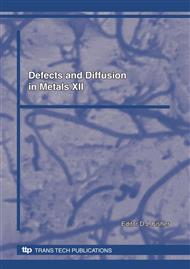[1]
W. K. Warburton and D. Turnbull, Diffusion in Solids: Recent Developments ed. A. S. Nowick and J. J. Burton, Acad. Inc. (1975) p.172.
Google Scholar
[2]
C. Herzig, DIMETA-82, Proc International Coference, held at Tihany 1982, F.J. Kedvas and D. L. Beke, Trans. Tech. Pub. (1983) p.923.
Google Scholar
[3]
J. W. Miller, Phys. Rev. Vol. 188 (1969) p.1074.
Google Scholar
[4]
W. K. Warburton, Phys. Rev B, vol. 7 (1973) p.1341.
Google Scholar
[5]
F. C. Frank and D. Turnbull, Phys. Rev. Vo. 104 (1956) p.617.
Google Scholar
[6]
W. K. Warburton, Phys. Rev B, vol. 11 (1975) p.4945.
Google Scholar
[7]
S. Fujita, J. Phys. Chem. Solids, vol. 49 (1988) p.41.
Google Scholar
[8]
S. Ishioka, H. Nakajima and M. Koiwa, Phil. Mag A, vol. 55 (1987) p.359.
Google Scholar
[9]
W. A. Harrison, Pseudopotential in theory of metals, NY: Benjamin, (1966).
Google Scholar
[10]
A. Ghorai, Defect and Diffusion Forum, vol. 278 (2008) p.25.
Google Scholar
[11]
A. Ghorai, Defect and Diffusion Forum, vol. 293 (2009) p.11.
Google Scholar
[12]
A. Ghorai, Defect and Diffusion Forum, vol. 294 (2009) p.113.
Google Scholar
[13]
A. Ghorai, Phys. Rev. B, vol 46 (1992) p.5229.
Google Scholar
[14]
M. Cohen and V. Heine, Solid State Phys. eds. H. Ehrenreich, F. Seitz and D. Turnbull, (Academic, Inc. ) vol. 24 (1970) p.55.
Google Scholar


